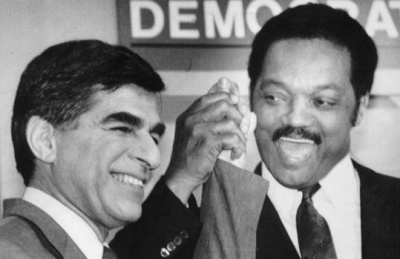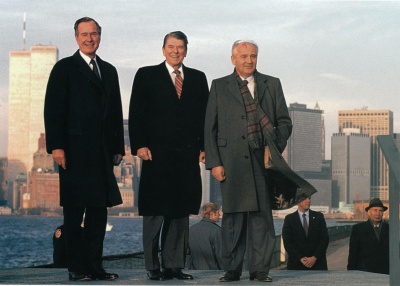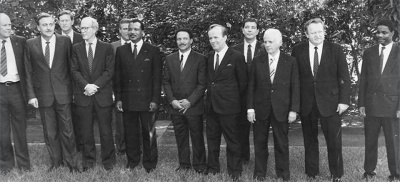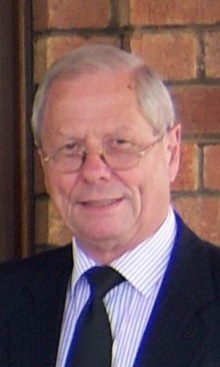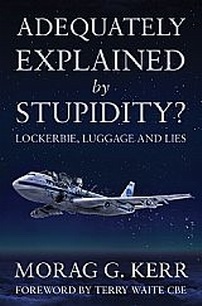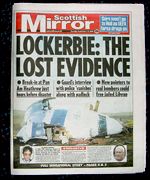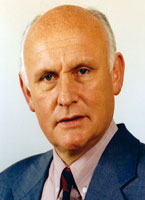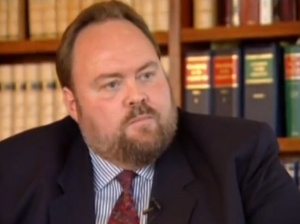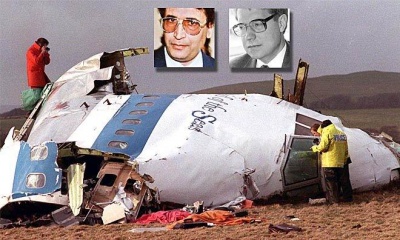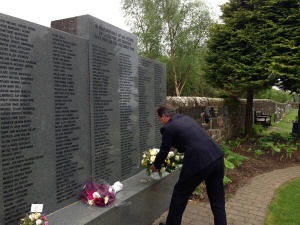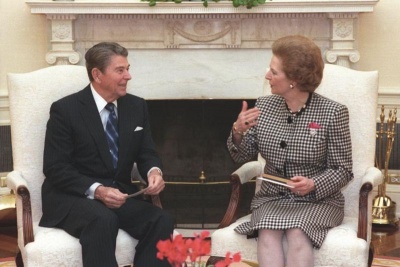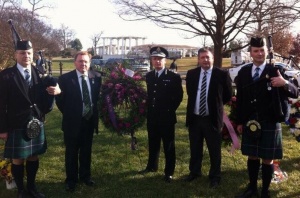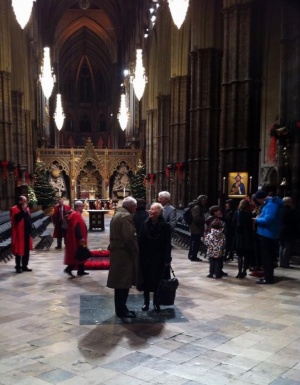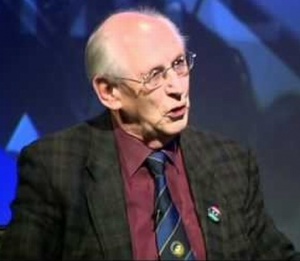The How, Why and Who of Pan Am Flight 103
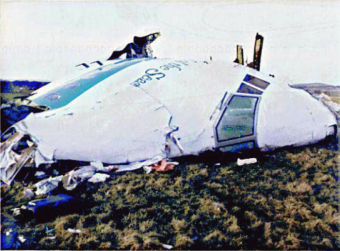 | |
 |
The How, Why and Who of Pan Am Flight 103 is an attempt to summarise the story of Pan Am Flight 103 which on 21 December 1988 exploded at 31,000 feet killing all 259 people on board, and 11 in the town of Lockerbie, Scotland.[1] Like the rest of the site, it is a work in progress, not necessarily to be regarded as definitive. Supporting discussion is particularly welcome on the this article's discussion page. |
Geopolitics leading to Lockerbie
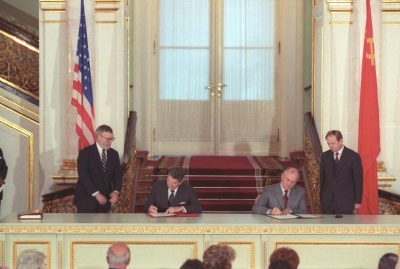
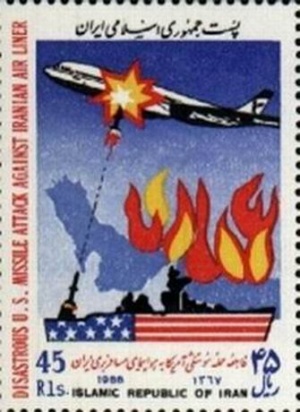
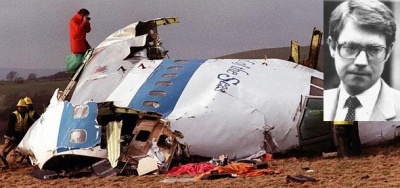
US President Ronald Reagan set out on his first-ever trip to Moscow on 25 May 1988 stopping over for several days in Finland's capital, Helsinki, "to adjust to the time change".[2] The meeting in Moscow which began on 29 May 1988 between President Reagan and Soviet leader Mikhail Gorbachev was their fourth summit, and was notable for Reagan's retraction of his Soviet Union Evil Empire epithet.
At their separate news conferences on 1 June 1988, a US official reported that Reagan and Gorbachev had found "important common ground on some aspects of the search for a Namibia - Angola settlement." The official said Chester Crocker, US Assistant Secretary of State for Africa, and Anatoly Adamishin, USSR Deputy Foreign Minister, had set 29 September 1988 as the target date for resolving outstanding differences on a settlement that would lead to the withdrawal of Cuban troops from Angola, which is supported by Moscow, and independence for South-West Africa, the disputed territory also known as Namibia, which had been illegally occupied by apartheid South Africa in defiance of UN Security Council Resolution 435.[3]
On 3 July 1988, the US Navy deliberately shot down Iran Air Flight 655 in the Persian Gulf killing all 290 civilian passengers and crew on the Airbus A300. Iran's Ayatollah Khomeini vowed that the skies would 'rain blood' in revenge. Months passed and no attempt at Iranian retaliation was made, even though there were hundreds of US passenger aircraft worldwide to target each day. A truce had been arranged for the duration of the US presidential election campaign, which ended on 8 November 1988 when Vice-President George Bush was elected to succeed the incumbent Ronald Reagan.[4]
Meanwhile, following the Moscow summit, a quick succession of talks took place in London, New York, Geneva, Cairo, and Cape Verde aimed at a negotiated regional peace settlement for Southern Africa. The Congo's capital Brazzaville hosted the final round of negotiations culminating in a preliminary agreement pursuant to UN Security Council Resolution 435 of 1978 which calls for the withdrawal of South African troops from Namibia. Known as the Brazzaville Protocol, this agreement also committed Cuba and South Africa to withdraw their troops from Angola, and was initialled on Tuesday 13 December 1988 by representatives of Angola, Cuba and South Africa.[5] Participants at the Brazzaville negotiations included South African Defence Minister Magnus Malan, Foreign Minister Pik Botha, Head of Military Intelligence General van Tonder, US Assistant Secretary of State for African Affairs Chester Crocker, French not-so-secret agent Jean-Yves Ollivier and Finland's Martti Ahtisaari.
The New York Accords, which gave effect to the Brazzaville Protocol, were scheduled to be signed the following week at UN headquarters in New York on Thursday 22 December 1988.[6]
United Nations Assistant Secretary-General & UN Commissioner for Namibia, Bernt Carlsson, who would have assumed control of the country until Namibia's first universal franchise elections had been held, was unable to attend the signing ceremony, being one of the 243 passengers killed when Pan Am Flight 103 crashed at Lockerbie on 21 December 1988.[7]
Following the UN Commissioner's death at Lockerbie, South African foreign minister Pik Botha went ahead and signed the Tripartite Accord on 22 December 1988. However, instead of handing control of Namibia to the United Nations, Pik Botha put the apartheid regime's Administrator-General, Louis Pienaar, in charge.
No investigation by the Scottish Police, the CIA, the FBI or the United Nations has ever been conducted into the evident targeting of Bernt Carlsson on Pan Am Flight 103, despite the branding of apartheid South Africa as a "terrorist state" by Governor Michael Dukakis, Democratic nominee in the 1988 US presidential election campaign.[8]
On 30 April 2015, at lunch with Lockerbie campaigner Patrick Haseldine, journalist and filmmaker Laurie Flynn recounted how he had arranged for UN Commissioner for Namibia Bernt Carlsson to travel from New York to Manchester for Granada TV's 1987 World In Action documentary "The Case of the Disappearing Diamonds":
- "Bernt insisted that we should visit several pubs in Manchester to sample the beer, which made for a very relaxed interview."
Haseldine was impressed with the Bernt Carlsson interview but told Flynn he was puzzled why there has been no inquiry into Bernt Carlsson's murder in the 1988 Lockerbie bombing:
- "The responsibility for investigating Bernt Carlsson's murder clearly rests with the Metropolitan Police since the bomb that brought down Pan Am Flight 103 was loaded at Heathrow. Why doesn't Scotland Yard launch a Bernt Carlsson murder inquiry?"[9]
Contents
How Pan Am Flight 103 was sabotaged
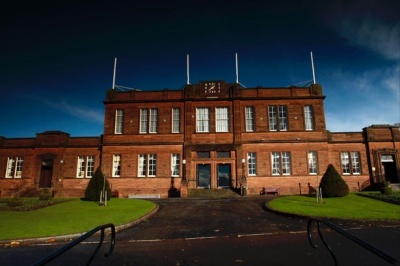
The report of the Lockerbie Fatal Accident Inquiry (FAI), which was held at Dumfries in Scotland from October 1990 to February 1991, explained how Pan Am Flight 103 was sabotaged. The FAI report concluded that Pan Am 103's 16 crew and 243 named passengers, including Bernt Wilmar Carlsson (born on 21 November 1938 and residing at Apartment 30, 207 West 106th Street, New York, New York 10025, USA), died from multiple injuries at about 1905 hours on Wednesday 21 December 1988 at or near Lockerbie, Dumfriesshire. The 259 deaths were caused by the detonation of an improvised explosive device located in luggage container AVE 4041 situated on the left side of the aircraft's forward hold. The detonation caused the nose and flight deck of the aircraft to become detached and the rest of the aircraft to descend out of control and to break up, eventually crashing into the ground killing eleven people in the town of Lockerbie. The bomb consisted of Semtex-type plastic explosive concealed in a Toshiba radio-cassette player contained in a Samsonite suitcase which was one of the pieces of baggage placed in the said luggage container by employees of Pan American World Airways at Heathrow Airport, London. The contents of said container consisted of six or seven pieces of baggage collected from the Interline shed and about thirty five pieces of baggage which had been unloaded from Pan American Flight 103A from Frankfurt to Heathrow and were labelled as destined for airports in the United States, including JFK Airport New York and Detroit. The bags from the Interline shed had been checked in by passengers such as Bernt Carlsson who had arrived at Heathrow on airlines other than Pan American World Airways to connect with Pan Am Flight 103 to New York.[10]
Thus the sabotage of Pan Am Flight 103 on 21 December 1988 was caused by someone who entered the Interline shed and put a Samsonite hardshell suitcase containing a bomb into baggage tin AVE4041, which was the eighth and final baggage container loaded onto the Boeing jumbo jet at London's Heathrow airport.
Evidence of Barry Walker
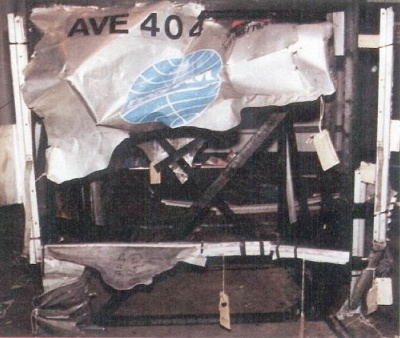
Lockerbie investigator Barry Walker's website "The Masonic Verses - Lockerbie and Related Scams" examines in forensic detail the evidence used to convict Abdelbaset al-Megrahi in 2001 for the 1988 Lockerbie bombing. In his article entitled "Lockerbie: The Heathrow Evidence", Barry Walker wrote:
- "The most important witness in the Lockerbie case was a Heathrow baggage handler, John Bedford, a loader/driver employed by Pan Am. Yet from the start his evidence was discounted or ignored, deemed to be of no relevance at all. On the afternoon of the 21 December 1988, Bedford was working at the Interline Baggage Shed a structure where Interline bags that arrived from other flights were brought and fed into the shed on a conveyor belt that extruded from the building. Here the bags were x-rayed and placed into luggage containers. Bedford had set aside luggage container AVE4041 for flight Pan Am 103. Bedford placed four or five suitcases, upright on their spines to the back of the luggage container then left the area to speak with his supervisor."[11]
In 1998, Barry Walker pointed out to the Crown Office that the primary suitcase had been introduced at Heathrow. Their response was he should wait to see the evidence presented at the trial. Having closely followed the Lockerbie trial proceedings, Walker eventually concluded that chief prosecutor Colin Boyd's central evidence had been fabricated. Barry Walker commented in 2014:
- Morag Kerr's book was belt and braces (then more belts and braces) but at its core the evidence for the Heathrow origin is much simpler. You don't need to write a book: the back of a postcard (or a stamp!) would suffice. If the "Bedford" Samsonite wasn't the primary suitcase then whose suitcase was it, and why was it never recovered unless it was the primary suitcase? How come it was "eliminated" in theory but never in actuality?[12]
Evidence of Dr Morag Kerr
Dr Morag Kerr, deputy secretary of the Justice for Megrahi campaign group, conducted a study into the Lockerbie luggage, publishing her findings in September 2012:[13]
- "Clipper Maid of the Seas carried eight containers of passenger luggage. Seven of these were filled with suitcases checked in at Heathrow, and sorted into the containers in the large and busy baggage build-up shed at the airport. The eighth was a container AVE4041 that had been partially loaded in the Interline Baggage Shed, and filled outside on the tarmac, taking luggage directly from the Pan Am feeder flight (Pan Am 103A) which had arrived late from Frankfurt with only 20 minutes to spare. That container was sent straight to the adjacent stand where the transatlantic flight (Pan Am 103) was preparing to depart, without entering the terminal buildings.
- "On Christmas Eve 1988, three days after the disaster, the first piece of blast-damaged container framework was brought in from the fields to the east of Lockerbie. This was the first positive indication that the crash had indeed been caused by an explosion, as many had suspected from the outset, and it also indicated that the explosion was associated with passenger hold luggage rather than cabin baggage or cargo.
- "Baggage handler John Bedford’s police statements reveal that when he set up the container to receive luggage for Pan Am 103, there were already two suitcases sitting beside the x-ray machine. He duly placed the cases in the container, upright with the handle(s) up, at the back, to the extreme left of the flat part of the floor. During the afternoon another four or five cases arrived, which he added to the line he had begun, working from left to right. At about quarter past four, as all was quiet, he went off for a tea break with his supervisor Peter Walker.
- "The only luggage which could possibly have arrived in the shed before Bedford set up the container just after two o’clock was Mr Carlsson’s single suitcase and Nicola Hall's suitcase. However, although Miss Hall was booked on Pan Am 103, her suitcase was sent to New York on Pan Am 101 which left at mid-day. Thus the 'bomb bag', having been substituted for Nicola Hall's suitcase, must have been adjacent to Bernt Carlsson's grey Presikhaaf hardshell suitcase. Mr Carlsson’s case was the most severely damaged of the group, but even that was not presented in court as having sustained damage consistent with its having been underneath the bomb, and since it is known to have been placed immediately behind the bomb suitcase within a foot or so of the IED, it would have been expected to be severely damaged in any event."[14]
On 21 December 2013, the twenty-fifth anniversary of the Lockerbie bombing, Morag G Kerr's book "Adequately Explained by Stupidity? Lockerbie, Luggage and Lies" was published.[15]
Unlawful baggage switch
Nicola Jane Hall, aged 23 years, of Sandton, South Africa, was in seat 23K on Pan Am Flight 103 when the aircraft exploded over Lockerbie.
To get to London's Heathrow airport, Nicola Hall had travelled overnight from Johannesburg on South African Airways (SAA) Flight 234 with a high-powered apartheid regime delegation which included foreign minister Pik Botha, defence minister Magnus Malan and military intelligence chief General Neels van Tonder. Because SAA had been banned from flying direct to and landing in the United States (on account of the 1986 Comprehensive Anti-Apartheid Act) the South African party were all booked for onward travel by the US carrier Pan Am from London, Heathrow to JFK, New York.
After an eleven-hour flight, SA234 arrived at Heathrow at 07:20am. Pik Botha and his party were booked on Pan Am Flight 101 departing Heathrow at 11:00am to New York for the signing ceremony of the Namibia independence agreement at UN headquarters on the following day Thursday, 22 December 1988.
Although she was not in Pik Botha's official party, and was booked on the fatal evening flight Pan Am 103 departing Heathrow at 18:00pm, Nicola Hall's suitcase did not accompany her. It had been wrongly transferred at Heathrow to the morning flight Pan Am 101.
That South African Airways were involved in unlawfully switching baggage that day was confirmed by a Pan Am security officer, Michael Jones, at the Lockerbie Fatal Accident Inquiry (FAI) in October 1990.[16] Jones told the FAI a breach of aviation rules had been committed because the suitcase of South African passenger, Miss Nicola Hall, had been put on the earlier Pan Am 101 flight (with Pik Botha's delegation) whereas Miss Hall was booked – and died – on PA 103.[17]
Primary suitcase
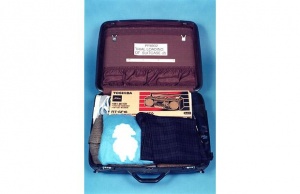
At about 20:00pm (GMT) on 20 December 1988, when flight SA234 took off from Johannesburg airport, full details of the flight's passenger manifest were transmitted to South African Airways office in London. This was the cue for a team of Civil Co-operation Bureau operatives, led by the CCB's London-based director Eeben Barlow, to break through a security door at Terminal 3 of Heathrow airport leading to the Interline Baggage Shed from where flights would be loaded the following day. The CCB team then ingested the primary suitcase (or "bomb bag") through this security door and tagged it for loading on Pan Am Flight 103.[18] For baggage reconciliation purposes, this Samsonite hardshell primary suitcase would replace Nicola Hall's bag (which would be diverted to Pan Am Flight 101). Thus the "bomb bag" and Bernt Carlsson's grey Presikhaaf hardshell suitcase were the first two pieces of luggage placed in the AVE4041 baggage container by loader/driver John Bedford.
Heathrow security guard Ray Manly, who discovered that the padlock had been cut on security door CP2 leading to the Pan Am baggage area, told the Lockerbie appeal court at Camp Zeist in 2002:
- "I believe it would be possible for an unauthorised person to obtain tags for a particular Pan Am flight and then, having broken the CP2 lock, to have introduced a tagged bag into the baggage build up area."
Manly immediately reported the break-in to the police but was not interviewed by Scotland Yard's Anti-Terrorist Squad until 31 January 1989. The officers who interviewed Manly apparently did not pursue the lead or pass on the information.[19] No mention of the Heathrow break-in was made at the 2000-2001 Lockerbie trial of the two Libyans Megrahi and Fhimah.[20]
Ray Manly's account of the break-in at Heathrow remained hidden for over twelve years, then suddenly made front page news on 11 September 2001 in the Scottish Mirror ("Lockerbie: The Lost Evidence") and was carried by BBC News that morning at 08:42 GMT ("Key Lockerbie 'evidence' not used").[21]
This short-lived Lockerbie story was effectively buried a few hours later when reports of the 9/11 attacks in America began to swamp the media.[22]
Was this a PFLP-GC bomb?
Marwan Khreesat, a Jordanian double agent who infiltrated the Popular Front for the Liberation of Palestine - General Command (PFLP-GC), told FBI special agent Edward Marshmann and forensic investigator Thomas Thurman in November 1989 that he had built five barometrically-triggered aircraft bombs when he was in Neuss, West Germany in October 1988. German BKA police intercepted four of these devices in November 1988 following the arrest of a PFLP-GC terrorist cell in Neuss. Khreesat said that the fifth bomb had been taken by a senior PFLP-GC agent named Abu Elias, who escaped arrest in Germany. That fifth device could have been supplied to the South African CCB in London, who planted the bomb at Heathrow airport and destroyed Pan Am Flight 103 just 38 minutes after take-off.[23]
Or a DMI bomb?
In 1986, South Africa's Directorate of Military Intelligence (DMI) allegedly caused an aircrash, in which President Samora Machel of Mozambique was killed. Soviet aviation experts, who investigated the crash of Machel's Tupolev aircraft, believed that a decoy navigational beacon had been installed on the South African side of the border with Mozambique, and was tuned in to the unique radio frequency used by Maputo airport's beacon. The decoy beacon would have diverted the presidential aircraft away from its intended flightpath to Maputo and towards a mountainside.
Two years later and buoyed by the success of this sabotage operation, which was attributed by South Africa's internal Margo Commission of Inquiry to pilot error, SA's DMI might have adapted their decoy beacon technique. With assistance from Israeli intelligence, they could easily have developed it into a radio detonator. SA Civil Cooperation Bureau operatives would have installed the bomb on Pan Am 103 once it was confirmed that their target, Bernt Carlsson, was to join the flight at Heathrow. The bomb would have been set to detonate when Pan Am 103 was prompted by the Dean Cross navigational beacon to re-tune to 123.95 MHz, Shanwick Oceanic Control's unique radio frequency.
Within a week of the death of Bernt Carlsson on flight Pan Am 103, his office safe at the United Nations had allegedly been broken into. And his apartment, which had been sealed by the UN's security staff, had also apparently been burgled. Furthermore, neither his girl-friend, Sanya Popovic, nor his sister, Inger Carlsson-Musser, was able to identify 'one single shred of anything in his checked luggage at the property store in Lockerbie'.
- "His bag was sitting at Heathrow, in the baggage area, from early that day. There is quite an important question about it, as neither I nor his sister was able to identify the bag. Just didn't seem like his (it was apparently immediately underneath the one containing the bomb, and quite considerably shattered). Not to mention the size was totally off (much too small)," says Sanya Popovic.
- "I was quite surprised to find that despite our reactions to that bag, the Crown chose to say there was a definitive identification. Which there certainly wasn't," declared Sanya Popovic.
Meanwhile, the apartheid administration insisted its own appointee, Louis Pienaar, was put in charge of South-West Africa (Namibia) in the run-up to that territory's first universal franchise election in November 1989. The main opposition party, SWAPO, was swept to power with 57% of the vote—but short of the two-thirds necessary for SWAPO to be able to change the constitution that was imposed on Namibia.
There is little doubt that apartheid South Africa, at the time a regional superpower and armed with nuclear weapons (developed jointly with Israel), and with its so-called dirty tricks operation Longreach, funded by General Neels van Tonder's Directorate of Military Intelligence (DMI), would be fully aware of the arrest of the PFLP-GC Frankfurt cell, the "Helsinki warning", the motives of Libya and Iran for revenge against the United States, and had the expertise to design a bomb capable of bringing down the target aircraft. The motive and opportunity to commit the crime were both in place, as was the plan designed by Craig Williamson.[24]
Why Pan Am Flight 103 was sabotaged
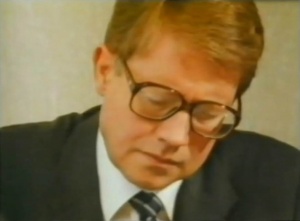
Why blow up Pan Am Flight 103 on 21 December 1988?[25] Iran could have targeted hundreds of other American aircraft to avenge the downing by the US Navy of Iran Air Flight 655 on 3 July 1988. Even truer if it was Colonel Gaddafi's revenge for Ronald Reagan's bombing of Libya in April 1986. There must have been something very special about that particular aircraft on that particular date. One of the passengers was UN Commissioner for Namibia Bernt Carlsson. Newspaper reports quickly identified Bernt Carlsson as the highest profile victim.
According to these reports, Bernt Carlsson was on his way to New York to attend the signing ceremony on 22 December 1988 at United Nations headquarters of the New York Accords granting independence to Namibia, which had been illegally occupied by apartheid South Africa in defiance of UN Security Council Resolution 435. Following the UN Commissioner's death at Lockerbie, South African foreign minister Pik Botha went ahead and signed the Tripartite Accord. However, instead of handing control of Namibia to the United Nations, Pik Botha put the apartheid regime's Administrator-General, Louis Pienaar, in charge.
No investigation by the Scottish Police, the CIA, the FBI or the United Nations has ever been conducted into this compelling circumstantial evidence of the targeting of Bernt Carlsson on Pan Am Flight 103, despite the branding of apartheid South Africa as a "terrorist state" by Michael Dukakis, the Democratic nominee in the 1988 US presidential election campaign.[26]
Carlsson's "secret meeting"
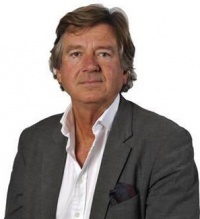
Jan-Olof Bengtsson is the political editor of Kvällsposten newspaper in Malmö, Sweden, and a renowned investigative journalist. Mr Bengtsson's most important work - although perhaps the least publicised - is his series of three articles in Sweden's iDAG newspaper on 12, 13 and 14 March 1990. Never published in the English language, the iDAG articles featured Sweden's UN Commissioner for Namibia Bernt Carlsson who was the most prominent victim of Pan Am Flight 103 which was sabotaged over Lockerbie, Scotland on 21 December 1988. Bengtsson reported that the diamond mining giant De Beers had been heavily criticised by Bernt Carlsson in a 1987 TV documentary "The Case of the Disappearing Diamonds", and were threatened with prosecution by the UN for over-exploitation of Namibia's diamonds. Bengtsson alleged that Commissioner Carlsson's arm had been twisted by De Beers into making a stopover in London for a secret meeting and into joining the doomed flight, rather than taking as he had intended a Sabena flight direct from Brussels to New York:[27]
- "Bernt Carlsson, UN Commissioner for Namibia, had less than seven hours to live when at 11.06am on 21 December 1988 he arrived in London on flight BA 391.
- "Strictly speaking he was meant to fly directly from Brussels to New York in time for the historic signing of the Namibia Independence Agreement the day after. But Bernt Carlsson could not make it. He had a meeting. An important meeting with a 'pressuriser' from the South African diamond cartel, which was so secret that evidently not even Javier Pérez de Cuéllar, UN Secretary-General, knew anything about it. Here iDAG maps out the last 24 hours in the life of Bernt Carlsson.
- "The memorial service in the Folkets Hus in Stockholm on 11 January 1989 for Bernt Carlsson gathered most of our Heads of Government, representatives of the Namibia independence movement SWAPO and Javier Pérez de Cuéllar, the UN Secretary-General.
- "When he died in the Pan Am bombing, Bernt Carlsson was less than 24 hours away from the fulfilment of his dreams - the signing of the Namibia agreement in New York which would finally pave the way to a free and independent Namibia. This was supposed to be the climax of his career with the UN, a career that began in December 1986 when he was appointed Commissioner for Namibia. Bernt Carlsson had great support from SWAPO but much less so from South Africa because of that country's substantial economic interests in Namibia: an interest in gold, uranium but above all in diamonds.
- "Javier Pérez de Cuéllar in his speech at the memorial ceremony on a cold day in January last year [1989] described the last 24 hours in the life of Bernt Carlsson:
- 'Bernt Carlsson was returning to New York following an official visit to Brussels where he had spoken to a Committee within the European Parliament about the Namibia agreement,' Pérez de Cuéllar began. 'He stopped briefly in London to honour a long-standing invitation by a non-governmental organisation with interests in Namibia.'
- "Pérez de Cuéllar was wrong. True, Bernt Carlsson's trip to Brussels had been planned almost six months earlier. But his decision to return to New York via London was only made on 16 December 1988. The meeting in London was definitely not a long-standing invitation by Namibia sympathisers."
Call for independent inquiry
In September 2009, former Labour MEP Michael McGowan called for an urgent independent inquiry led by the United Nations into the Lockerbie disaster. McGowan wrote that he was personally affected by the crash:
- "As President of the Development Committee of the European Parliament, I had invited Bernt Carlsson, the Assistant Secretary-General of the United Nations and UN Commissioner for Namibia, to call in at Brussels in December 1988. He was on his way back to the United States from Namibia and agreed to address members of the Development Committee, which he did. In Brussels, he spoke about his hopes for an independent Namibia and the end of apartheid in South Africa to a packed meeting of MEPs.
- "And afterwards he confirmed his acceptance to visit Leeds the following year to give the 1989 Peace Lecture in honour of Olof Palme, the former Swedish Prime Minister, who was murdered in Stockholm on February 28, 1986. He said how much he was looking forward to coming to Leeds to pay tribute to his fellow Swede with whom he had worked closely as international secretary of the Social Democratic Party of Sweden, and also as a special adviser to Palme. Bernt Carlsson did not make that visit to Leeds in 1989. He was a passenger on Pan Am Flight 103 and he died when the plane was blown up over Lockerbie on December 21, 1988. He was a giant of diplomacy, gentle, quiet, but a tough negotiator. His death, like that of his friend and fellow Swede, Prime Minister Palme, who was murdered in the street in Stockholm returning with his wife from a night at the cinema, was the result of a terrorist act and remains a mystery.
- "A call by the British Government for an independent inquiry led by the United Nations to find out the truth about Pan Am Flight 103 is urgently required. We owe it to the families of the victims of Lockerbie and the international community to identify those responsible. That Bernt Carlsson was on that plane should be an extra incentive for the UN to take action in view of the fact that this impressive diplomat was dealing with some of the most sensitive and violent situations being perpetrated by the brutal apartheid regime in both South Africa and Namibia, besides his work in the Middle East. The best tribute to the lives and families of the 270 victims of Lockerbie, including Bernt Carlsson, and the most positive action for the international community to take against "terrorism", is to launch an independent inquiry into this gross act of mass murder. Nothing less will suffice."[28]
Who sabotaged Pan Am Flight 103?
In 1988 the State Security Council (SSC), chaired by apartheid South Africa's President P W Botha, decided that Sweden's UN Commissioner for Namibia Bernt Carlsson, an avowed anti-apartheid activist, had to be eliminated. General Magnus Malan's Civil Cooperation Bureau was tasked by SADF Military Intelligence chief General van Tonder to kill him.
SSC member South African 'superspy' Craig Williamson was responsible for selecting high profile targets who were deemed to be hostile to the apartheid regime. Thus in 1986, Craig Williamson successfully targeted and eliminated Sweden's Prime Minister Olof Palme and Mozambique's President Samora Machel without leaving an obvious apartheid trail. It is inconceivable that British Intelligence and the CIA did not at least tacitly approve these murders.
Logistically, targeting Bernt Carlsson must have seemed a much more difficult challenge for Craig Williamson. Bernt Carlsson had a long-standing invitation to address a committee meeting of the European Parliament in Brussels on Tuesday 20 December 1988, and was booked to fly back that day on Sabena from Brussels direct to New York. On Thursday 22 December 1988 Bernt Carlsson was scheduled to attend a signing ceremony at United Nations headquarters of an agreement granting independence to Namibia, which had been illegally occupied by apartheid South Africa in defiance of UN Security Council Resolution 435, and would take charge of the territory on behalf of the United Nations. Bernt Carlsson changed his itinerary when the South Africans persuaded him to fly from Brussels to London on Wednesday 21 December 1988 for a morning meeting with the diamond mining conglomerate De Beers and then travel onward on the evening flight Pan Am 103, accompanied by a South African negotiating party headed by Foreign Minister Pik Botha. (South African Airways were banned from flying direct to the United States by the 1986 Comprehensive Anti-Apartheid Act.)
Unfortunately, Bernt Carlsson had been duped: Pik Botha's delegation took the morning flight Pan Am 101 to New York on 21 December 1988.
Diamonds
In January 2010, Gordon Douglas Brown argued that it was the illegal exploitation of Namibian diamonds that led to the targeting of Bernt Carlsson:
- With reference to the murder of UN Commissioner for Namibia, Bernt Carlsson, and 269 other innocent folk in the attack on Pan Am Flight 103 over Scotland in 1988, it would not be out of line to consider the De Beers/Anglo American Group a prime suspect as it had the Motive, Means and Opportunity to carry out such an attack.
- MOTIVE: with regards to Motive, the Group had a pressing need:
- 1. to prevent an in-depth investigation of its decades-long illegal gem diamond mining operations in Namibia in breach of United Nations Decree No. 1 which Bernt Carlsson was about to conduct,
- 2. to prevent the United Nations Commissioner for Namibia from further uncovering and quantifying the secretive high-grading/overmining practice which the Group had embarked upon with the object of depleting Namibia’s more valuable gem diamond resources ahead of an internationally recognised independence settlement; an illegal practice which had been brought to public note through the findings of the Thirion Judicial Commission of Inquiry,
- 3. to hide from public scrutiny the human rights abuses and discriminatory employment practices the Group’s Namibian employees had been subjected to for more than 50 years,
- 4. to ward off a massive claim for damages the United Nations could legally have instituted against the Group on behalf of the people of Namibia,
- 5. to frustrate any action likely to threaten the Group’s dominant control of diamond mining in Namibia and prevent its lucrative concessions from being legally expropriated in the public interest and granted to a less controversial and more responsible mining company. This effectively would have ended the De Beers Diamond Cartel’s monopolistic control of the world diamond industry.
- MEANS: Through the Group’s established contacts and dealings with the CCB, CIA (through Maurice Tempelsman), BOSS and Executive Outcomes, The Group most certainly possessed the means to carry out such an attack. Breaking into Heathrow Airport’s luggage handling section would have posed little difficulty to any one of these organisations. There was money and expertise aplenty to carry out such an operation.
- OPPORTUNITY: There was more than adequate time to plan and execute this heinous criminal act as Bernt Carlsson’s movements and travel arrangements, dictated in part by De Beers in London, were known to the Group well in advance. It was the ideal crime as nobody would ever suspect Bernt Carlsson was the target and therefore no finger would ever point at De Beers/Anglo American. This cowardly attack was conveniently labelled the dastardly work of a terrorist organisation.[29]
Uranium
According to the Namibian Sun of 8 January 2014:
- The bombing of Pan Am Flight 103 over Lockerbie in Scotland on December 21, 1988 had helped to keep Namibia’s Rössing Uranium Mine in business, after a lead investigator into allegations of the illegal exportation of uranium from the then South-West Africa (SWA) perished in the deadly attack.
- Bernt Carlsson, the United Nations (UN) Assistant Secretary-General and Commissioner for Namibia at the time, was the highest-profile victim of that bombing, according to a report released this week.
- The report, compiled by former British diplomat Patrick Haseldine, suggests that Carlsson was the main target of the bombing - in order to end his high-profile investigation into allegations that there was a secret contract and operations arranged by British-based Rio Tinto Zinc Corp to import into Britain uranium (Yellowcake) from Rössing in Namibia.[30]
Another Swede bites the dust
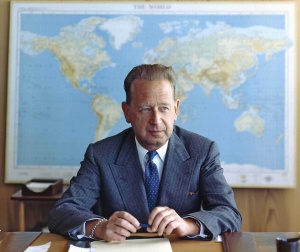
Twenty seven years before Pan Am Flight 103, United Nations Secretary-General Dag Hammarskjöld was en route to negotiate a cease-fire in the former Belgian Congo when his McDonnell Douglas DC-6 airliner crashed near Ndola, Northern Rhodesia (now Zambia) on 18 September 1961. Hammarskjöld and fifteen others perished in the crash. A civil aviation inquiry, held immediately after the event, was unable to ascribe a cause to the crash; a Rhodesian commission of inquiry in February 1962 attributed it to pilot error; the United Nations’ own Commission of Inquiry in April 1962, like the Rhodesian civil aviation investigation, found itself unable to determine the cause of the crash. The UN Inquiry’s report was presented to the General Assembly, which by resolution 1759 (XVII) of 26 October 1962 requested the new Secretary-General to inform the General Assembly of any new evidence relating to the disaster.[31]
On 14 December 2014, The Guardian reported that Sweden was about to present a Resolution to the UN General Assembly calling for the creation of a UN Panel of Experts to examine new evidence about the Hammarskjöld crash “and to assess its probative value”. The Resolution with 41 co-sponsors from around the world was expected to win overwhelming support. Annika Söder, State Secretary in the Swedish foreign ministry, said:
- “I would expect a consensus decision to be taken, so it would be passed by acclamation. I can’t see anyone being against steps for getting clarification.”
Annika Söder said there could a delay of in earmarking the necessary funds for a Panel of Experts – initially about $300,000 (£240,000). Once established, the Panel of Experts could request crucial documents about the crash from the US National Security Agency and the CIA, as well as still-classified records held by the UK and other western European states.[32]
On 31 December 2014, the UN General Assembly approved by consensus a Resolution that requested Secretary-General Ban Ki-moon to appoint an independent Panel of Experts to examine the new information that has emerged on the death of former UN chief Dag Hammarskjöld.[33]
"Who Killed Hammarskjöld?"
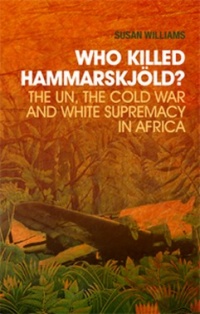
In 2011, Dr Susan Williams’ book "Who Killed Hammarskjöld?" was published.[34] It offered no definite answer to its own question, but it marshalled a striking quantity of evidential material which had come to light in the intervening years and prompted the diplomat's nephew Knut Hammarskjöld to call for the United Nations to reopen its Inquiry.[35] In response to Dr Williams’ book, Lord Lea of Crondall assembled an international Enabling Committee and invited Sir Stephen Sedley, a recently retired Lord Justice of Appeal for England and Wales, to chair a Commission of Jurists to inquire into the disaster. Justice Wilhelmina Thomassen of the Netherlands, Justice Richard Goldstone of South Africa and Ambassador Hans Corell of Sweden agreed to serve with Sir Stephen as Commissioners.[36]
On 9 September 2013, the Hammarskjöld Commission report was published.[37] It recommended reopening the adjourned 1962 United Nations inquiry into the UN Secretary-General Dag Hammarskjöld's death on the basis of 'significant new evidence'. UN Secretary-General Ban Ki-moon thanked the Commission of Jurists for their work and the Enabling Committee for its initiative in setting up the Commission. He said the UN Secretariat will closely study the findings of the Commission's report.[38]
It is striking to note the points of similarity between the UN Secretary-General Dag Hammarskjöld and UN Assistant-Secretary-General Bernt Carlsson: both Swedes; both UN diplomats; both concerned with mineral-rich countries (Congo and Namibia); both operating in Cold War circumstances where the West sought to contain Soviet expansionism (especially in Central and Southern Africa).
Involvement of MI6, CIA and BOSS
On 19 August 1998, Archbishop Desmond Tutu, chairman of South Africa's Truth and Reconciliation Commission (TRC), stated that recently uncovered letters had implicated the British MI6, the American CIA and South African BOSS intelligence services in Hammarskjöld's aircrash. The letters, headed "South African Institute for Maritime Research" (SAIMR) — said to be a front company for the South African military — include references to the US Central Intelligence Agency (CIA) and the British MI6 security service. The CIA last year (1997) opened its files on Cold War assassinations and admitted it ordered the murder of Patrice Lumumba, Congolese independence hero and pro-Soviet prime minister.[39]
Resulting from a meeting between MI6, special ops executive and the SAIMR, the letters were marked "Top Secret", dubbed the mission as "Operation Celeste" and stated:
- "It is felt that Hammarskjöld should be removed. I want his removal to be handled more efficiently than was Patrice."
- "Allen Dulles (then director of the CIA) agrees and has promised full co-operation from his people."
One letter said TNT was to be planted in the wheel bay, and would explode as the wheels retracted after take-off. Another said the bomb would be detonated when the wheels came down for landing.[40]
On 9 November 1992, two former UN officials, George Ivan Smith and Conor Cruise O'Brien, alleged in a letter to The Guardian that mercenaries shot down Mr Hammarskjöld's plane. The Guardian quoted Mr Smith as saying the mercenaries were employed by a Belgian mining company, Union Miniere de Haut-Katanga, and were also acting under orders from British and American mining interests that he did not identify. Union Miniere issued a statement denying the allegations and saying the investigating commission "concluded there was no proof to support charges that the plane was shot down or that there was an explosion in mid-air." The two ex-officials said the companies were worried that Mr Hammarskjöld would succeed in ending the rebellion and harm their businesses. They described the rebel Katangan leader Moise Tshombe as a "stooge" of Belgian mining concerns. The mercenaries were ordered to fire a warning shot at the United Nations plane and "the warning shot must have hit a wire," the letter said. The plane, a DC-6B, carrying Hammarskjöld and 13 other people crashed near Ndola, in what was then Northern Rhodesia and is now part of Zambia. All aboard were killed.[41]
On 19 August 1998, a spokesman for the British Foreign Office said:
- "Intelligence agents of the United Kingdom do not go around bumping people off."[42]
The Foreign Office told the BBC that the letters may have been created in the 1960s as Soviet misinformation or disinformation.[43]
Archbishop Tutu's statement went on to say that the TRC, whose mandate expired at the end of July 1998, was unable to investigate the veracity of the letters or the allegations that South African and/or Western intelligence agencies played a role in Hammarskjöld's aircrash. Tutu passed the letters to South African Justice Minister Dullah Omar.
Congo's huge mineral deposits
Swedish aid worker, Göran Björkdahl, who investigated Dag Hammarskjöld's death in the aircrash, said:
- "It's clear there were a lot of circumstances pointing to possible involvement by western powers. The motive was there – the threat to the west's interests in Congo's huge mineral deposits. And this was the time of black African liberation, and you had whites who were desperate to cling on. Dag Hammarskjöld was trying to stick to the UN charter and the rules of international law. I have the impression from his telegrams and his private letters that he was disgusted by the behaviour of the big powers."[44][45][46]
Gaddafi calls for UN investigation
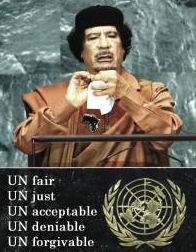
On 16 September 2009, Patrick Haseldine wrote on Professor Black's blog:
- "Another option would be for the United Nations to launch an investigation that would command international co-operation", says The Sunday Herald. This interesting idea is not developed by the newspaper, however. I am reminded that the Libyan leader, Colonel Gaddafi, is scheduled to address the UN General Assembly in New York on 23 September 2009. Libya currently occupies one of the 15 seats on the UN Security Council, and with the Libyan former foreign minister, Ali Treki, about to become president of UNGA, it would be very surprising if Gaddafi did not use his UN speech to call for a 'United Nations Inquiry into the death of UN Commissioner for Namibia, Bernt Carlsson, in the 1988 Lockerbie bombing'.[47]
In fact, in his long, rambling speech to the 64th session of the United Nations General Assembly on 23 September 2009, Colonel Gaddafi didn't even mention Pan Am Flight 103, but did call upon the Libyan president of UNGA, Ali Treki, to institute a UN investigation into the assassinations of Congolese prime minister, Patrice Lumumba, who was overthrown in 1960 and murdered the following year, and of UN Secretary-General Dag Hammarskjöld in 1961.[48]
Collusion by Western Governments
Barry Walker opines that the innocence of Megrahi directly indicates collusion in the Lockerbie bombing by Western governments:
- "The conviction of al-Megrahi was not a so-called 'miscarriage of justice'. One does not get convicted of mass murder by accident or mistake. If there was a plan to 'blame' Libya or to incriminate Megrahi and his co-defendant then it must have been conceived and partly implemented before the bombing. The alternative to Megrahi’s guilt is that the authorities set out to incriminate an innocent man (or at least innocent of this crime). Although not explicitly stated in the Camp Zeist Judgement, this is a point the Trial Judges grasped. The alternative to Megrahi’s guilt is not simply that he was 'fitted-up' but that Western Governments colluded in the bombing itself."[49]
Cover-up by MI6
On 14 January 2014, these three comments appeared on Professor Black's The Lockerbie Case blog in relation to an article by William Blum in the Foreign Policy Journal of 10 January 2014:[50]
1. pesceman said: So we know al-Megrahi was innocent. Of that there is no doubt. Why was the Heathrow break-in totally ignored from the very start - the Anti-Terrorism Police in the UK don't seem able to recall the event at all???? It is pretty obvious that the South African Civil Cooperation Bureau were wholly responsible and assisted in the cover up by UK Intelligence and UK Police.
2. Robert Black said: It is by no means obvious. And the notion that the CCB was responsible stems from Patrick Haseldine's fevered imagination. There is nothing whatever that counts as evidence to support it. No further comments giving credence to Mr Haseldine's ravings will be accepted on this blog.
3. Quincey Riddle aka Robert Forrester said: Dear Peaceman, I agree entirely with Robert Black vis-a-vis the South African theory. Mr Haseldine is frankly certifiably doolally and an extremely manipulative individual, whom I felt obliged to expel from JFM for his conduct. I would be careful too about laying too much store on the issue of the Heathrow break-in as being linked to Pan Am 103, maybe it was maybe it wasn't. In my view, the only significant factor here is that COPFS appears to have hidden a tree in a forest in terms of the evidence made available to the defence. That from my perspective is as reprehensible as the Gauci payments being denied to the court. Robert.
Hammarskjöld Commission
On 9 September 2013, the Hammarskjöld Commission, a panel of prominent international jurists, released its 61-page report indicating there was "significant new evidence" and recommending the reopening of the inconclusive 1962 UN investigation of the plane crash. Specifically, the jurists cited "persuasive evidence that the aircraft was subjected to some form of attack or threat as it circled to land at Ndola." That possibility alone, the Commission concluded, is "sufficient evidence to merit further inquiry."
In a statement issued after the Hammarskjöld Commission reported its findings in The Hague, Netherlands, the United Nations endorsed the call for a new probe, saying the world body for whom the Swedish diplomat worked "is among the most concerned in arriving at the whole truth of the circumstances leading to his death."
The Commission report resurrected a telling comment by former President Harry Truman to a New York Times reporter a day after the plane crash:
- "Dag Hammarskjöld was on the point of getting something done when they killed him," Truman was quoted as saying. When pressed to say to whom "they" referred, Truman replied: "That's all I've got to say on the matter. Draw your own conclusions."[51]
Since the Hammarskjöld Commission is recommending that the adjourned 1962 UN Inquiry should now be reopened, perhaps it is time to extend that inquiry to cover the deaths of both senior UN diplomats: Dag Hammarskjöld and Bernt Carlsson.[52]
Dual UN Inquiry
In November 2013, former diplomat Patrick Haseldine created this e-petition calling upon HM Government (Foreign and Commonwealth Office) to:
- "Support a United Nations Inquiry into the deaths of UN Secretary-General Dag Hammarskjöld and UN Assistant Secretary-General Bernt Carlsson"
- On 9 September 2013, the London-based Hammarskjöld Commission reported that there was "significant new evidence" about the plane crash that killed United Nations Secretary-General Dag Hammarskjöld and recommended that the adjourned 1962 UN Inquiry should now be reopened.
- UN Assistant Secretary-General Bernt Carlsson was the highest profile victim on Pan Am Flight 103 which was sabotaged over Lockerbie on 21 December 1988.
- Since Bernt Carlsson's death has never been investigated, the British Government should propose extending the remit of the new UN Inquiry to cover the deaths of both senior diplomats: Dag Hammarskjöld and Bernt Carlsson.
The e-petition was open for signature by UK citizens and residents from 13 November 2013 to 13 May 2014.[53]
On 14 May 2014, he sent this email to David Cameron via the Prime Minister's Office:
- Dear Prime Minister,
- My e-petition to HM Government had 56 signers when it closed yesterday. That petition requested HMG to "Support a United Nations Inquiry into the deaths of UN Secretary-General Dag Hammarskjöld and UN Assistant Sec-Gen Bernt Carlsson".
- On 13 May 2014, I created four new e-petitions each calling on you to "Open all MI6 files on state sponsored murders".[54][55][56][57]
- I hope you can agree to open these MI6 files to assist the UN in its reopened investigation.
- Patrick Haseldine
- Emeritus Professor of Lockerbie Studies
On 27 January 2015, following news that a UN Panel of Experts is to investigate Dag Hammarskjöld's death, Haseldine created an international petition calling upon UN Secretary-General Ban Ki-moon to extend the remit of the new UN Inquiry to cover the unsolved mystery deaths of both Dag Hammarskjöld and Bernt Carlsson.[58]
Naming names
Evidence recently uncovered alleges that Britain's Secret Intelligence Service MI6 played a coordinating role with the American Central Intelligence Agency CIA and South African Bureau of State Security BOSS in the murder of Congolese Prime Minister Patrice Lumumba and in the plane crash which killed UN Secretary-General Dag Hammarskjöld, both of which took place in 1961.[59][60]
This Wikispooks synthesis suggests that high-level politicians including George H W Bush, Ronald Reagan and Margaret Thatcher encouraged agents of the CIA, MI6 and the South African Civil Cooperation Bureau (CCB) to conspire in the targeting and murder of UN Assistant Secretary-General Bernt Carlsson by sabotaging Pan Am Flight 103 on 21 December 1988.
Despite the call in September 2009 by former Labour MEP Michael McGowan for an urgent independent inquiry led by the United Nations into the Lockerbie disaster, no such UN Inquiry has taken place.
A United Nations Inquiry will find the following individual directly responsible for shooting down Dag Hammarskjöld's aircraft on 18 September 1961:
- Jan van Risseghem (deceased), Belgian mercenary & former South African Air Force (SAAF) pilot;
and, that these individuals either conspired to murder, or were complicit in targeting, Bernt Carlsson in the Lockerbie bombing of 21 December 1988:
- South African President P. W. Botha (deceased)[61],
- General Magnus Malan (deceased)[62],
- Foreign Minister Pik Botha[63],
- Head of SADF Military Intelligence Major-General Neels van Tonder, who controlled the dirty tricks operation Longreach,
- South African Superspy Craig Williamson[64],
- South African mercenary Lt-Col Eeben Barlow[65],
- Former President of Finland Martti Ahtisaari, who attended the December 1988 negotiations in Brazzaville where the Bernt Carlsson murder plot was hatched,
- Former US Assistant Secretary of State Chester Crocker, whose 'linkage policy' delayed Namibia's independence for 10 years,
- French not-so-secret agent Jean-Yves Ollivier.
25th Anniversary Memorial Services
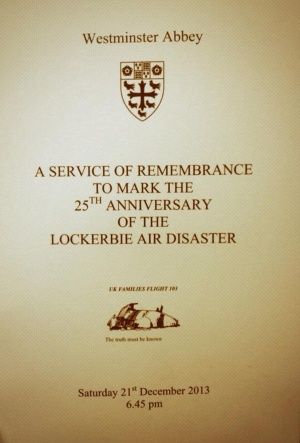
On 21 December 2013, a Westminster Abbey Service of Remembrance to mark the 25th Anniversary of the Lockerbie air disaster took place. Relatives and friends of the victims, and dignitaries including Scotland's Deputy First Minister, Nicola Sturgeon, attended in great numbers.[66] The Order of Service provided for a minute's silence at 7.00 pm as Big Ben chimed on the hour. A Scots piper then played "Flowers of the Forest". This was followed by a moving Speech from Dr Jim Swire; the most marvellous Address by Rev. John Mosey; and, thanks to the Dean of Westminster, Dr John Hall, for a magnificent ceremony.
Memorial services were also held in Lockerbie itself, and in the memorial cairn at the Arlington National Cemetery, Washington DC, to coincide with the time of day the tragedy struck.[67] David Mundell, the Scotland Office Minister and MP for Lockerbie, travelled to America to represent the UK Government.[68] Also attending were Frank Mulholland, the Lord Advocate, Eric Holder, the US Attorney General, and Robert Mueller, the outgoing director of the FBI.[69]
Reflections by Dr Jim Swire
This is the text of Dr Jim Swire's address at the Lockerbie memorial service in Westminster Abbey:
- Lockerbie was a revenge attack, but no philosophy can justify the slaughter of innocent people. In the West we counter the threat of "terrorism" though intelligence gathering, and the bringing to justice of those who hate. Please pray for all who do this desperate work for us.
- In our family Flora was our beautiful vivacious first born of three wonderful children. She had been on her way to spend Christmas with her American Jewish boyfriend. They had both become outstanding young medical scientists invited to their own research projects at our premier neurological institute at Queen’s Square in London where they met. Through him she had met with Rabbi Albert Friedlander: he called her a great seeker after truth.
- We are the lucky ones, in the UK and USA. Not only do we live in two of the most free and safe countries in the world, but we relatives also had the joy of living with those we loved until their untimely deaths. It was Abraham Lincoln who at Gettysburg proclaimed a new birth of freedom for the people of the United States.
- Here, St Thomas à Becket born on this day, but 700 years before Lincoln, was slaughtered in Canterbury Cathedral for upholding the Church against his King. I claim Habeas Corpus as I say in this ancient Abbey that I do not believe that our Governments have told us all the truth they know about this terrible tragedy.
- Recently in a cold suburban car park in Sweden with the snow beginning to fall, I was watching a small town house. All day long the curtains were drawn shut and the blinds down. Inside was a man who has spent his whole life as a terrorist. I believe he played a key role in the Lockerbie atrocity. Too afraid to answer the bell himself, he sent his wife to an upstairs window to threaten.
- How would I feel in meeting one of those deeply involved: what were the roots of his hatred, could one forgive? Nelson Mandela made forgiveness look easy. But even a Truth and Reconciliation Commission cannot work unless first the truth is known.
- When I first met the late Abdelbaset al-Megrahi face to face in Greenock prison, though he was a practising Muslim, he had bought me a Christmas card in the prison shop; in it he had written "Dr Swire and family, please pray for me and my family."
- He died my friend. Over Christmas, if you pray, please pray for his innocent family, but also for all those who wrestle with hatred, that they may be healed by God’s love. Please pray also that we who will sit down at a Christmas table with chairs forever empty may find peace.[70]
Address by Reverend John Mosey
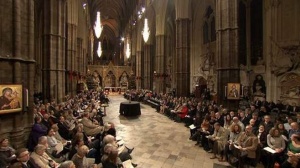
We have gathered here with the specific purpose of remembering those who we have lost. But as we remember them there is always another "remembering" lurking not far away: the remembering of the way in which they were snatched mercilessly from us. It is what we do with this remembering that I want to think about for a few minutes. I go back to my final words in this place at the tenth anniversary.
"Five days after ‘Lockerbie’, I sat in my daughter’s bedroom. I suppose that I was looking for a foundation on which to build my strategy for dealing with this deep wound I had received. I was drawn to the words which the Apostle Paul wrote to the Christians in Rome suffering under the Emperor Nero, ‘Don’t be overcome by evil, but overcome evil by doing good’."
I was born in Coventry as the Nazi bombs were raining down on the city. Whilst studying at the Lanchester College of Art and Technology I often ate my lunchtime sandwiches in the nearby ruins of the old cathedral. Soon after the blitz they had taken two of the charred beams from the rubble and fastened them in the form of a cross on the east wall placing beneath them the words, "Father, forgive". Little did I think then that there would come a time in my life when I was going to have to give a great deal of thought to this subject of "Forgiveness"; what it is and what it is not.
Whatever our definition of "Forgiveness" it is clear from reading the Bible, and the teachings of Jesus in particular, that forgiveness and reconciliation are a huge part of God’s agenda. The "Sermon on the Mount" is acclaimed widely, even by those of other or no religious persuasions as being one of the very finest codes for living. In it Jesus, directly after giving us the "Lord’s Prayer" containing "Forgive us our debts as we forgive our debtors", gave it double emphasis and made it a condition for God’s forgiveness. "For if you forgive men their trespasses, your heavenly Father will also forgive you. But if you do not forgive men their trespasses, neither will your Father forgive your trespasses." For any who call themselves "Christian" un-forgiveness is not an option. George Herbert, the seventeenth-century poet and theologian put it well, "He who cannot forgive breaks the bridge over which he himself must pass."
In my boyhood I had a friend who went into hospital with appendicitis. After the operation he came home but a few days later had to return to the hospital with an infection in the wound. He died shortly afterwards, not of the appendicitis but because of the secondary infection. The damage we inflict on ourselves by harbouring anger and bitterness can be far more serious than the initial wound.
How we deal with this second "remembering" is crucial. I have seen lives destroyed, not by the cruel events of life, but by the anger and bitterness (often justified) that they have allowed and even encouraged to fill their thoughts. I return to St Paul’s words, "Don’t be overcome by evil, but overcome evil by doing good". Our anger and bitterness only hurt us. The objects of our anger, if they are aware of it, usually couldn’t care less: it even adds interest to their investment.
The recently departed president Nelson Mandela once said, "As I walked out the door toward the gate that would lead to my freedom, I knew if I didn't leave my bitterness and hatred behind, I'd still be in prison."
Forgiveness does not mean we are soft on crime. If you beat me up outside and steal my wallet I will forgive you - but I won’t stop the policeman from arresting you. Forgiveness is a very personal thing but the Bible clearly teaches that the law is God’s protection for society. The law, civic or international (such as it is) must, within the limits of its remit, pursue and prosecute but if it becomes vengeful or vindictive it is out of order.
Our people were murdered in revenge for an act of Western aggression which was, in turn, an act of revenge. It is by doing something to try to break the vicious circle of hatred and aggression that we become winners.
On that fifth morning after her murder I sat in our daughter’s room remembering the previous evening’s news that it was a bomb that had destroyed Pan Am 103. I recalled the cries for revenge and thought, "If I want someone dead because my child is dead I become no better than the terrorists: I bring myself right down to their level."
The words of Gandhi came to mind. "‘An eye for an eye’, and the world will soon be blind." We could not have a better example than that of Nelson Mandela’s apparent total lack of vengefulness and his reaching out for reconciliation.
We remember those we lost with love, sorrow and pain but it is what we do with this other "remembering" that can affect, not only our personal lives but the wider world we live in.
So, "we will remember them" and remember those who did this dreadful deed and those who have assiduously sought to hide the truth from us. We have witnessed the death of honour, truth and justice and so the death of trust. Evil and injustice must be bravely confronted and every effort made to expose the truth but we must pursue our quest without malice or desire for revenge.
The Christmas message of the Gospel, symbolised by the incarnation and the cross, is reconciliation. "God was in Christ, reconciling the world to himself." Let us seek, at least on a personal level, to break the never ending cycle of aggression. "Don’t be overcome by evil, but overcome evil by doing good."[71]
Statement on behalf of Pan Am Flight 103 victim Bernt Carlsson
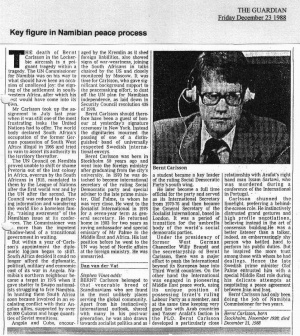
At each of the 25th Anniversary Memorial Services (Westminster Abbey, London; Lockerbie, Scotland; and Arlington National Cemetery, Virginia), the following statement on behalf of Pan Am Flight 103 victim Bernt Carlsson was expected to be read out:
A senior United Nations diplomat was killed along with 269 other victims when Pan Am 103 exploded over Lockerbie on 21st December 1988.
Sweden’s Bernt Carlsson, who was the UN’s Assistant Secretary-General and Commissioner for Namibia, had addressed the European Parliament’s Development Committee in Belgium on 20th December. From Brussels, he flew to Heathrow on the morning of 21st December and met with diamond mining conglomerate De Beers. After that meeting in London, Bernt Carlsson returned to the airport in good time to catch the transatlantic flight Pan Am 103 to JFK.
At UN headquarters, upon signature of the New York Accords on 22nd December 1988, Bernt Carlsson would have taken charge of the UN Trust Territory, Namibia, which had been illegally occupied for many years by apartheid South Africa. Because Bernt Carlsson didn’t make it to the signing ceremony, the South African appointed Administrator-General Louis Pienaar took charge of Namibia.
In December 2013, Dr Morag Kerr’s freshly-published book has conclusively demonstrated that the bomb bag containing the IED which sabotaged Pan Am 103 was loaded at Heathrow Airport, and was placed side by side with Bernt Carlsson’s suitcase in the aircraft’s baggage container AVE4041. Dr Kerr’s new evidence together with other significant material that has come to light now needs to be evaluated by an independent body - ideally a UN Commission of Inquiry - to determine whether Bernt Carlsson had been the Pan Am 103 target all along.
A new investigation twenty five years after the event may seem unlikely to advance the search for truth and justice, but it is worth noting that fifty years after the 1961 plane crash in which UN Secretary-General Dag Hammarskjöld was killed, new evidential material became available and was published by Dr Susan Williams in her 2011 book "Who Killed Hammarskjöld?"
In response to Dr Williams’ book, Lord Lea of Crondall assembled an international Enabling Committee and invited Sir Stephen Sedley, a recently retired Lord Justice of Appeal for England and Wales, to chair a Commission of Jurists to inquire into the disaster.
On 9th September 2013, the Hammarskjöld Commission report was published. It recommended reopening the adjourned 1962 United Nations Inquiry into the UN Secretary-General Dag Hammarskjöld's death on the basis of 'significant new evidence'. The UN Secretariat is currently studying the findings of the Commission's report.
In November 2013, the establishment of a Dual UN Inquiry was proposed and an e-petition calling upon the British Government to: "Support a United Nations Inquiry into the deaths of UN Secretary-General Dag Hammarskjöld and UN Assistant Secretary-General Bernt Carlsson" was created. The e-petition, which was open for signature by UK citizens and residents from 13th November 2013 to 13th May 2014, was unsuccessful.[72]
- References:
- 1. U.N. Officer on Flight 103 New York Times
- 2. Key figure in Namibian peace process The Guardian
- 3. Adequately Explained by Stupidity? Lockerbie, Luggage and Lies by Dr Morag Kerr, published December 2013
- 4. UN Secretary-General Dag Hammarskjöld dies in plane crash archive material from The Guardian
- 5. Who Killed Hammarskjöld? Susan Williams' formidable book review by Dr Philip Muehlenbeck (The George Washington University)
- 6. Report of the Hammarskjöld Commission published 9th September 2013[73]
43rd Lockerbie victim
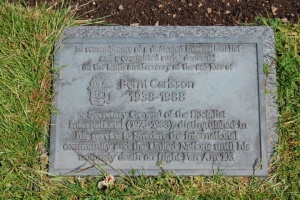
On 6 January 2014, The Ecologist published an article entitled "Flight 103: it was the Uranium",[74] which began:
Mystery continues to surround the 1988 downing of Pan Am Flight 103 at Lockerbie - who did it, how, and why? After 25 years study of the topic Patrick Haseldine reveals the shocking truth.
- A little over two weeks ago, my wife and I were seated beside the flower bedecked pulpit in a packed Westminster Abbey.
- There was an eerie hush as Big Ben's muffled chimes tolled 7:00 pm - the exact moment 25 years earlier when Pan Am Flight 103 was sabotaged over Lockerbie in Scotland on 21st December 1988.
- All 259 passengers and crew were killed, as were 11 people in the town. The names of the 270 Lockerbie bombing victims were listed alphabetically in the Order of Service, and five relatives took it in turns to read them out.
- Thus it was Jane Swire, mother of victim Flora and wife of Dr Jim Swire, who read the name of the 43rd victim on the list: Bernt Wilmar Carlsson.
- United Nations Assistant Secretary-General and Commissioner for Namibia, Bernt Carlsson, was Lockerbie's highest profile victim, yet the authorities and the media never mention him. Why?
- As comedian Kenneth Williams used to say: "I think the answer lies in the soil."
- More specifically, I believe the answer lies in the processed uranium ore (Yellowcake) that was illegally extracted from Namibia in the period 1976 to 1989. A TV documentary film in March 1980 described succinctly what was going on:
- "World In Action investigates the secret contract and operations arranged by British-based Rio Tinto Zinc Corp to import into Britain uranium (Yellowcake) from the Rössing Uranium Mine in Namibia, whose major shareholders are the governments of Iran and South Africa.
- "This contract having received the blessing of the British government is now compromising the UK's position in the United Nations negotiations to remove apartheid South Africa from Namibia, which it is illegally occupying."[75]
- Within four months of the Lockerbie disaster, Prime Minister Margaret Thatcher decided to make a whistle-stop tour of southern Africa, and found time to visit Namibia's Rössing Uranium Mine where she was accompanied by David Cameron, then a youthful Conservative Central Office researcher.
- Mrs Thatcher was so impressed by the Rössing Uranium Mine that she declared it made her "proud to be British".
- While Mrs Thatcher was in Namibia, she put improper pressure on the UN's man, Martti Ahtisaari, head of the United Nations Transition Assistance Group, to permit the South African Defence Force (SADF) to take action against SWAPO soldiers who were peacefully returning to Namibia to vote in the November 1989 independence elections.
- As a result, as many as 308 SWAPO soldiers were killed - "shot in the back" according to former SADF major Nico Basson.
- Whether Mrs Thatcher could have persuaded UN Commissioner for Namibia, Bernt Carlsson, to agree to such treachery we shall never know since Mr Carlsson was assassinated fifteen weeks earlier, on 21st December 1988.[76]
The Ecologist article can be read in full here. On 7 January 2014, Global Research also published the article, heading it "The Downing of Flight 103 over Lockerbie: It was the Uranium" with the attribution "Copyright Patrick Haseldine, The Ecologist, 2014".[77]
References
- ↑ "Report on the accident to Boeing 747-121, N739PA at Lockerbie, Dumfriesshire, Scotland on 21 December 1988"
- ↑ "Cold War: Moscow (Reagan-Gorbachev) Summit (Shultz memoirs)"
- ↑ "MOSCOW SUMMIT: GORBACHEV CRITICIZES REAGAN, SEEING 'MISSED OPPORTUNITIES,' BUT CALLS VISIT A 'MAJOR EVENT'; SUMMIT TALKS END" New York Times, 2 June 1988
- ↑ "Lockerbie: Ayatollah's vengeance exacted by Botha's regime"
- ↑ "Protocol of Brazzaville"
- ↑ "Agreement Among the Peoples Republic of Angola, the Republic of Cuba, and the Republic of South Africa"
- ↑ "U.N. Officer on Flight 103" The New York Times December 22, 1988
- ↑ "Dukakis Backers Agree Platform Will Call South Africa 'Terrorist'"
- ↑ "Scotland Yard to launch Bernt Carlsson murder inquiry"
- ↑ Sheriff Principal John S Mowat's Fatal Accident Inquiry into the Lockerbie Disaster"
- ↑ "Lockerbie: The Heathrow Evidence"
- ↑ "You don't need to write a book: the back of a postcard (or a stamp!) would suffice"
- ↑ "Heathrow baggage transfers and the Bedford suitcase"
- ↑ "Lockerbie - the fundamental error"
- ↑ "Adequately Explained by Stupidity? Lockerbie, Luggage and Lies"
- ↑ "Rules broken on Lockerbie flight" The Guardian Wednesday, October 31, 1990
- ↑ "Lockerbie Fatal Accident Inquiry"
- ↑ "Pan Am 103: South Africa Guilty"
- ↑ "Mirror dossier will clear me" Heathrow expose to help Lockerbie appeal
- ↑ "'Break-in' before Lockerbie bombing"
- ↑ "Key Lockerbie 'evidence' not used"
- ↑ "Lockerbie: Heathrow break-in revealed"
- ↑ "Lockerbie: Ayatollah's Vengeance Exacted by Botha's Regime"
- ↑ "Major Craig Williamson: the 'real' Lockerbie bomber"
- ↑ "Why Flight 103?"
- ↑ "Dukakis Backers Agree Platform Will Call South Africa 'Terrorist'"
- ↑ "Bernt Carlsson in a secret meeting with 'pressuriser' from the Diamond Cartel"
- ↑ "The best tribute to the 270 victims of Lockerbie is to find out the truth"
- ↑ "Lockerbie: A Prime Suspect"
- ↑ "Lockerbie disaster kept Rössing in business"
- ↑ "19 September 1961: UN secretary-general Dag Hammarskjold dies in plane crash" from The Guardian's archive
- ↑ "UN poised to open fresh inquiry into 1961 Dag Hammarskjöld crash"
- ↑ "Secretary-General Ban Ki-moon to appoint an independent Panel of Experts"
- ↑ "Who Killed Hammarskjöld?: the UN, the Cold War and White Supremacy in Africa"
- ↑ "NSA may hold key to Dag Hammarskjöld mystery"
- ↑ "Hammarskjöld Commission of Jurists"
- ↑ "The Dag Hammarskjöld Commission report"
- ↑ "Ban Ki-moon to study findings of Commission linked to death of former UN chief Hammarskjöld"
- ↑ "Notes for Media Briefing" by Archbishop Desmond Tutu, Chairperson of the Truth And Reconciliation Commission, 19 August 1998
- ↑ "Letters Say Hammarskjöld Death Western Plot"
- ↑ "Ex-U.N. Officials Question Hammarskjöld Crash"
- ↑ "Britain denies conspiracy to kill UN chief", The Guardian, Thursday August 20, 1998
- ↑ "UN assassination plot denied"
- ↑ "Dag Hammarskjöld: evidence suggests UN chief's plane was shot down"
- ↑ "I have no doubt Dag Hammarskjöld's plane was brought down", Göran Björkdahl, The Guardian, 2011 Aug 17
- ↑ "Call for new inquiry following emergence of new evidence" The Guardian 2011 Sept 16
- ↑ "Patrick Haseldine writing on Professor Black's blog"
- ↑ "Gaddafi's address to UN General Assembly" 23 September 2009
- ↑ "Part III Lockerbie - Criminal Justice or 'War by Other Means' (1)
- ↑ "The Bombing of Pan Am Flight 103: Case closed?"
- ↑ "'Significant new evidence' cited in 1961 death of U.N.'s Hammarskjöld"
- ↑ "Dag Hammarskjöld death: UN 'should reopen inquiry'"
- ↑ "Support a United Nations Inquiry into the deaths of UN Secretary-General Dag Hammarskjöld and UN Assistant Secretary-General Bernt Carlsson"
- ↑ "The Petition Site"
- ↑ "Change.org"
- ↑ "38 Degrees"
- ↑ "Avaaz.org"
- ↑ "UN Secretary-General Ban Ki-moon: Solve two of the Cold War’s greatest mysteries"
- ↑ "MI6 Arranged Patrice Lumumba's Assassination, Daphne Park, Former British Spy, Claimed"
- ↑ "'Significant new evidence' cited in 1961 death of U.N.'s Hammarskjöld"
- ↑ "From Chequers to Lockerbie"
- ↑ "South Africa’s Civil Co-operation Bureau (CCB) executed Iran’s revenge attack"
- ↑ "Why the Lockerbie flight booking subterfuge, Mr Botha?"
- ↑ "Craig Williamson: Lockerbie bomber"
- ↑ "Lockerbie: J'accuse...Eeben Barlow"
- ↑ "Lockerbie 25th Anniversary: Victims Remembered"
- ↑ "Lockerbie victims remembered on 25th anniversary - in pictures"
- ↑ "Lockerbie Remembered by David Mundell MP"
- ↑ "Mundell to attend Washington service in memory of Lockerbie victims"
- ↑ "'He died my friend': Dr Jim Swire's Westminster Abbey address"
- ↑ "SERMON GIVEN AT A SERVICE OF REMEMBRANCE TO MARK THE 25TH ANNIVERSARY OF THE LOCKERBIE AIR DISASTER" 21st December 2013 at 6:45 pm The Reverend John Mosey, UK Families Flight 103
- ↑ "Support a United Nations Inquiry into the deaths of UN Secretary-General Dag Hammarskjöld and UN Assistant Secretary-General Bernt Carlsson"
- ↑ Why Flight 103? On the 25th anniversary of the Lockerbie bombing of Pan Am Flight 103, Patrick Haseldine uncovers some salient facts that may shed light on the tragedy.
- ↑ "Flight 103: it was the Uranium"
- ↑ "World In Action 'Follow The Yellowcake Road'"
- ↑ Missing diplomatic links and the Lockerbie tragedy
- ↑ "The Downing of Flight 103 over Lockerbie: It was the Uranium"
